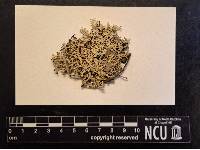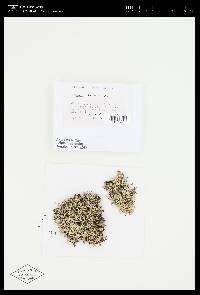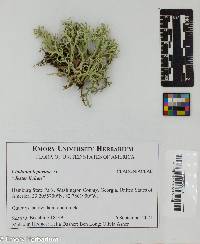
- Home
- Search
- Images
- Species Checklists
- US States: O-Z >
- US National Parks
- Central America
- South America
- US National Parks
- Southern Subpolar Region
|
|
|
|
Family: Cladoniaceae
Jester Lichen
[Cladonia cetrarioides Schwein.] |
MB#119184 TYPE. UNITED STATES. NORTH CAROLINA, Forsyth County, Salem, L.D. v. Schweinitz s.n. (UPS, lectotype designated by Ahti, 1993). Description. Lichenized fungus. Thallus weakly dimorphic to fruticose; primary thallus squamulose, rarely present; squamules appressed or ascending, < 1 mm greenish yellow above, whitish below; vegetative diaspores absent. Photobiont Asterochloris alga. Podetia 3-5 cm tall x 3 mm thick, greenish yellow, subcylindrical, swollen, often wrinkled, cupless, subdichotomously or irregularly moderately branched, forming cushions 10 cm across x 4 cm high. Branches spreading, the axils open or closed, terminal branches blunt or pointed. Podetial surface smooth or wrinkled. Ascomata biatorine apothecia 0.7-1.5 mm diam, subsolitary or clustered on branch apices; disk convex, red. Ascospores hyaline, oblong, simple, 7-14 x 2.5-5 μm. Pycnidia on branch tips, ovoid, 160-200 x 190-230 μm; pycnidial jelly red; conidia 7-10 x 1 μm, strongly curved. Chemistry. K+ yellow, KC+ gold, PD- or PD+ yellow; usnic, didymic acids major compounds; several chemical races known, ± correlated with geography. Substrate and Habitat. On sandy soil in open areas, also on wood. Distribution. Eastern North America and Caribbean (Cuba); in North Carolina primarily in coastal plain and piedmont ecoregions. Literature Ahti, T. (2000) Cladoniaceae. Flora Neotropica 78, Organization for Flora Neotropica and New York Botanical Garden, Bronx. 362 pp. Brodo, I.M., S. Duran Sharnoff & S. Sharnoff. (2001) Lichens of North America. Yale University Press, New Haven & London. 795 pp. Fink, B. (1935) The Lichen Flora of the United States. University of Michigan Press, Ann Arbor. Fries, E.M. (1831) Lichenographia europaea reformata. : Praemittuntur lichenologiae fundamenta. Compendium in theoreticum et practicum lichenum stadium. Lundae, typis Berlingianis, venditur apud E. Mauritium, Gryphiae (original description). Pino-Bodas, R. & S. Stenroos. (2021) Global Biodiversity Patterns of the Photobionts Associated with the Genus Cladonia (Lecanorales, Ascomycota). Microbial Ecology 82: 173–187. |
|
|
|




























































































